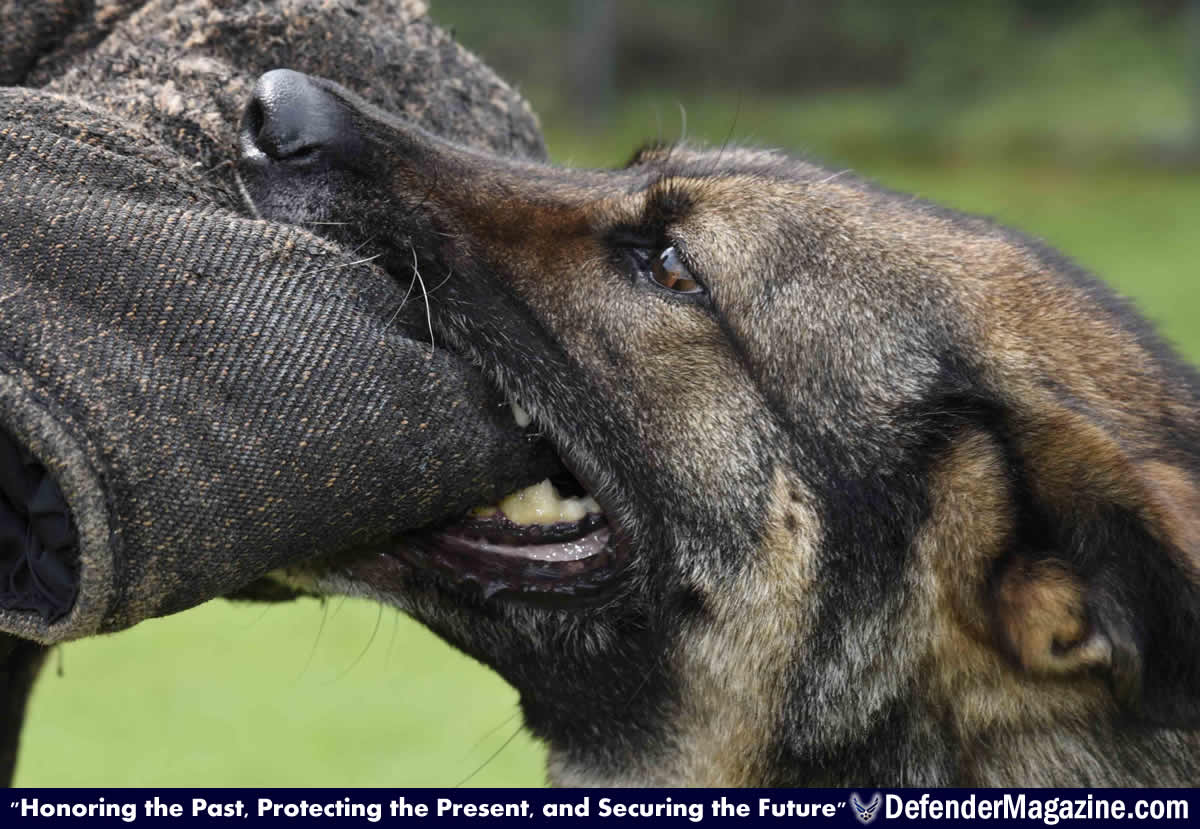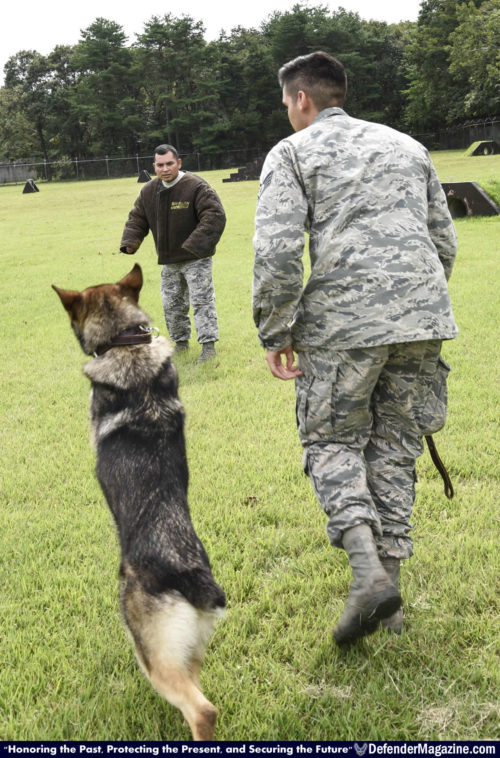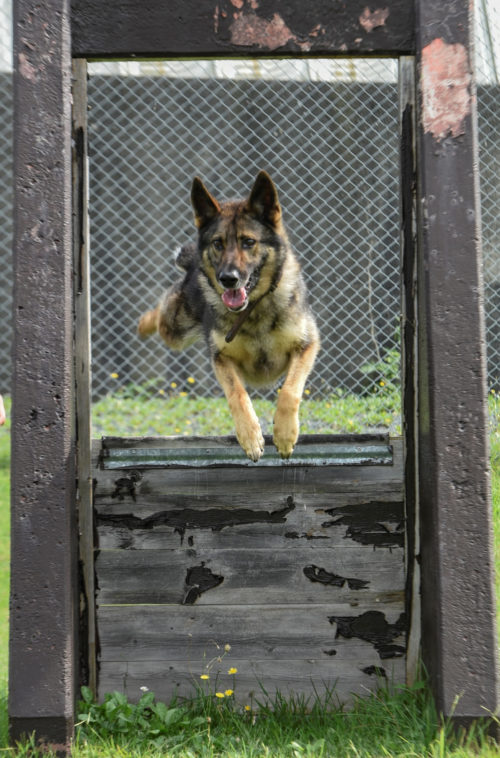
Karo, a military working dog with the 35th Security Forces Squadron, holds his opponent during an aggression simulation at Misawa Air Base, Japan, Sept. 7, 2016. The average force of bite for German Shepard breeds are 1,200 pounds of pressure per square inch. German Shepherds are primarily used as MWDs for their strong abilities in obedience, protection and tracking. (U.S. Air Force photo by Airman 1st Class Sadie Colbert)
09/15/2016 – MISAWA AIR BASE, Japan —
As the largest career field in the Air Force, it is the job of security forces squadrons to protect and defend the base. However, the Airmen don’t do it alone as they rely on their four-legged companions: military working dogs.
“The [K-9’s] abilities are incredible,” said Tech. Sgt. Juventino Salazar, the 35th Security Forces Squadron kennel master. “These military dogs can do a lot more than a typical patrol unit.”
Upon request, MWDs and their handlers provide security around the base in situations that call on their specialties in deterring foes with sheer force and tact.
“Our job is to provide detection capabilities for the installation,” Salazar said. “Having the capability to detect for explosives and narcotics along with the regular patrol of Misawa Air Base deters unauthorized items from entering the installation.”
Salazar added, they are definitely a force multiplier for the unit, meaning they allow the 35th SFS to have a broader scope of force tactics
Staff Sgt. Charles Sena, a 35th SFS MWD handler, explained there are two different types of specializations for the K-9s. They are trained in either explosives or narcotics, but most are dual-certified and also go through aggression and patrol training.
“Our section is an important asset not only because of the dogs’ detection capabilities,” said Sena. “We play a huge psychological role on the base as well. If someone has bad intentions they are most likely going to think twice about what they are doing.”
Sena added not just any dog can become a MWD. To be selected as a MWD, the K-9s are chosen at birth or at a young age and they go through their own rigorous training at Lackland Air Force Base, Texas.
He explained the MWD teams conduct daily detection and patrol training to keep them proficient, certified and mission ready.
“Training is fun and challenging at times,” said Sena. “It is rewarding to see all the work [the K-9 and handler] have put into training and see what you can overcome together.”
Although training is essential to teams’ stamina and performance ability, Sena said it is equally important to let the dogs take a break.
“Going on runs or playing fetch is nice for the [MWDs],” said Sena. “At the end of the day they are still dogs, and they need to be taken out of that working environment to let them enjoy that.”
As kennel master, Salazar said he stays on his toes by using training to identify areas that could use improvement such as tactical and searching techniques, making sure the MWD teams are always mission ready.
“Whenever a call does come,” said Salazar, “we have to be ready for it. Whether it’s searching vehicles at the gate, or patrolling the installation.”
By Airman 1st Class Sadie Colbert
35th Fighter Wing Public Affairs
Published September 15, 2016
Staff Sgt. Charles Sena, a military working dog handler, plays with his partner, Karo, a MWD, both assigned with the 35th Security Forces Squadron, before agility training at Misawa Air Base, Japan, Sept. 7, 2016. The MWD teams at Misawa conduct daily detection and patrol training to keep them proficient, certified and mission ready. (U.S. Air Force photo by Airman 1st Class Sadie Colbert)
Tech. Sgt. Juventino Salazar, kennel master, left, evades Karo, a military working dog, after being released by his partner Staff Sgt. Charles Sena, a MWD handler, all with the 35th Security Forces Squadron, during an aggression simulation at Misawa Air Base, Japan, Sept. 7, 2016. Most military working dogs are dual-certified in narcotics or explosives and also go through aggression and patrol training. (U.S. Air Force photo by Airman 1st Class Sadie Colbert)
Karo, a military working dog with the 35th Security Forces Squadron, leaps through an agility obstacle at Misawa Air Base, Japan, Sept. 7, 2016. Handlers are assigned with their K-9 partners as a team to either detect narcotics or search for explosives while patrolling the base to deter foes with force and tact. (U.S. Air Force photo by Airman 1st Class Sadie Colbert)
Staff Sgt. Charles Sena, a military working dog handler and Karo, a MWD, both assigned with the 35th Security Forces Squadron, stand together after finishing controlled aggression training at Misawa Air Base, Japan, Sept. 7, 2016. To be selected as a MWD, the K-9s are chosen at birth or a young age and go through their own rigorous training at Lackland Air Force Base, Texas. (U.S. Air Force photo by Airman 1st Class Sadie Colbert)



